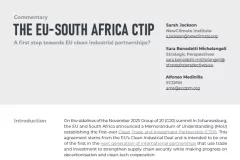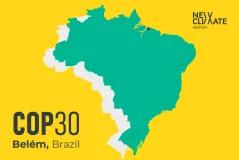Adopting the Paris Agreement Rulebook in Katowice at COP24 in December 2018 was an important moment for climate diplomacy, but the Paris Agreement and it’s rulebook alone will not save the climate. The adoption shows that multilateralism works, that countries can make joint decisions, also in the era of rising populism. But the pace of decisions is by far too slow to effectively meet the objectives of the Agreement. Ambitious climate action compatible with the agreed goal of limiting temperature increase to below 1.5°C is now needed by leaders to move the laggards along. Only then we have a slight chance to still stay within the 1.5°C limit.
What is the status?
Requirements and reality on climate protection do not match. The Paris Agreement states that the global average temperature increase should be limited to well below 2°C, working towards 1.5°C. Human activities since pre-industrial times have already caused an average 1.0°C increase. The IPCC special report on 1.5°C (see our contribution) points out the world’s operating limits loud and clear – we need to reach and sustain net‐zero CO2 emissions within the next three decades. This urgency has been echoed in many scientific efforts. The UNEP Emissions Gap Report finds that ambition must be tripled to keep to 2°C and quintupled for 1.5°C.
The Paris Agreement asks all countries to self-select actions that they will implement as their contribution to keeping this limit, known as Nationally Determined Contributions (NDCs). But NewClimate Institute’s flagship work, the Climate Action Tracker, shows that the proposals that countries have made so far would still lead to a temperature increase of 3.0°C – grossly insufficient to meet the agreed long-term goal. In addition, countries are slow in the implementation of the current climate proposals, the development of new, more ambitious ones is put aside by many countries and only a few engage in the development in long term strategies.
What was agreed in Katowice?
COP 24 was the culmination of a three-year process that began in 2015 at COP 21 in Paris to define the rules and procedures for implementing the Paris Agreement, in particular how to increase the level of ambition over time so that self-selected actions are in line with the global goals.
This “Paris Rulebook” provides a blueprint for how the treaty will work in detail and to ensure that countries do what they have committed to do. So far, countries had submitted proposed actions, but the process of what would happen next was unclear.
The Paris Rulebook includes the following key elements:
- All countries have to report on the progress of their actions every two years, providing, for example, their most recent greenhouse gas emissions and progress towards achieving their promised actions.
- A technical expert team will check if a country meets its promises. It will not judge on the adequacy of the promise made in the first place.
- A compliance committee starts to consider consequences if a country has not reported or is not keeping up to its promises. It can then - if the country agrees - recommend the development of an action plan, but not issue penalties.
- Every five years, countries will take stock of their collective progress towards the Paris goals (a process known as the global stocktake). This process will only assess collective progress at the international level and explicitly rules out country specific recommendations.
Two issues were postponed:
- Decisions on the rules for how market mechanisms could be used to trade emission credits between countries have been postponed until November 2019.
- A process to define the level of financial resources provided annually to developing countries will start only in November 2020.
Is it enough to avoid the climate crisis?
The Paris Agreement and its rulebook are essential and probably the best that could have come out of the process considering UN rules of consensus (no decision is made if a single country objects). But alone they are grossly insufficient for the task at hand. The system relies completely on self‑selected contributions. Country-specific recommendations by technical experts or during the global stocktake on where a country could do more are explicitly ruled out. A country is only held accountable to its own promises. If those are not met, consequences are initiated only with the consent of the country. Such consequence are limited to “naming and shaming” and are unlikely to pose significant threat.
We have known about the looming ambition gap since 2014 when the pledges for the Paris Agreement were made. It is clear that the longer we wait the deeper and more drastic the change must be. But since then, no major country has submitted an updated climate contribution. Countries can submit a new contribution at any time but have to at the latest in 2020. Even countries that have previously been important proponents of increased ambition at the international negotiations, have not increased their pledge. The EU, for example, has not, even though the already agreed renewable and efficiency targets would lead to much lower emissions in 2030 than the current climate proposal.
The rules agreed on in Katowice continue the principle of the Paris Agreement: All countries are on board for tracking their self-selected actions on climate change. At the same, the rulebook provides only very few obligations for countries to implement truly ambitious climate action at home.
Only small and indirect steps towards ambition raising were made in the runup of, or during, the conference:
- After an intervention by António Guterres, General Secretary of the United Nations, a coalition of countries including the EU, Canada, New Zealand and many developing countries from the Americas and Pacific declared that they intend to step up their ambition by 2020.
- The Marshall Islands submitted a revised NDC. The Marshall Islands’ NDC not only provides updated emission reduction targets for every five years up to 2030, but also an indication of what they would do beyond that to be able to achieve carbon neutrality by 2050.
- The EU commission developed and proposed 2050 climate neutrality plan, which still needs to be approved by all EU member states. Others, like New Zealand, have similar proposals on the table.
- The expansion of renewable energy in India is continuing and India will overachieve its pledge by far.
- Development banks announced that they will work to align their portfolios with the goals of the Paris Agreement (some methods already exist).
The negative messages dominated:
- Global CO2 emissions are projected to rise by more than 2% in 2018, after 2014 to 2016 had seen a plateau followed by an increase in 2017. A main contribution to this rise comes from China with estimated +4.7%.
- Countries like Germany came to the COP empty handed as its intent to phase out coal‑fired power had been postponed.
- After Trump, now also Bolsonaro, is at odds with the Paris Agreement and wants to increase the use of the Amazon rainforest, resulting in increased emissions from deforestation.
But the opportunities to raise ambition have never been as good as they are today. Since Paris, the costs for renewables dropped roughly by a third, countries can do much more today than only three years ago. In many places of the world (parts of USA, South Africa, Australia, Chile) building new wind and solar plants is cheaper than operating existing coal fired power plants. This leads to their expansion in those countries even if the federal government is going the opposite way (e.g. in USA and Australia).
If done right, more climate action can mean more secure and high-quality jobs, more energy security, and less air pollution (examples for EU, South Africa). Climate action is linked with achieving sustainable development goals and provides significant development opportunities for more jobs, better health, livable cities.
Cities, regions and businesses continue to showcase ambitious actions. Our input to the global climate action summit in September 2018 and to the UNEP Emissions Gap Report highlights the large potential of cities, regions and businesses to help narrow the emissions gap.
Transitions that are needed for 1.5°C are already happening at the speed needed in some sectors and regions, but not yet on the scale necessary.
What is needed now?
The Paris Agreement with its Rulebook is absolutely essential, but alone will not solve the problem. We need a four-point plan:
- Leaders: We now need leaders or champions that move ahead well before the UN climate summit that is planned by UN Secretary General for September 2019 with bold and ambitious action that is clearly compatible with the 1.5°C limit, committing to phase out CO2 emissions completely by 2050. E.g. Germany, France and UK could move the EU in that direction.
- Ambition coalitions: By September 2019, small coalitions of countries and interested businesses of critical mass should get together to take individual issues forward with high ambition and speed. Such coalitions could spur technology development that will spill over also to countries outside of this coalition (examples could be to support CO2-free freight transport to phase out CO2 emissions by 2040 or to provide stable financial support for CO2-free high-intensity heat for industry with a goal to have all new installations CO2-free by 2030).
- Long-term vision: Countries need to chart their own pathways to decarbonization by around mid-century. This vision needs to be aligned with the goal of the Paris Agreement. Countries’ contributions should represent a shorter-term planning on this pathway and should be submitted in 2020 together with their long-term vision. A critical element of this process is aligning financial flows with the temperature goal. This will avoid stranded assets and fossil fuel lock in.
- Outside support for the Paris Agreement process: A recognition of the urgency in all fora of multilateral cooperation is necessary, not just by the UNFCCC but also by the G20, the G7, the OECD, ASEAN and all other international fora for a need to treat this issue at the highest urgency. In addition, recommendations on what individual countries could do more have to come from other UN organisations, research and NGOs, as these will not come from the official Paris process but are essential to move countries forward.






